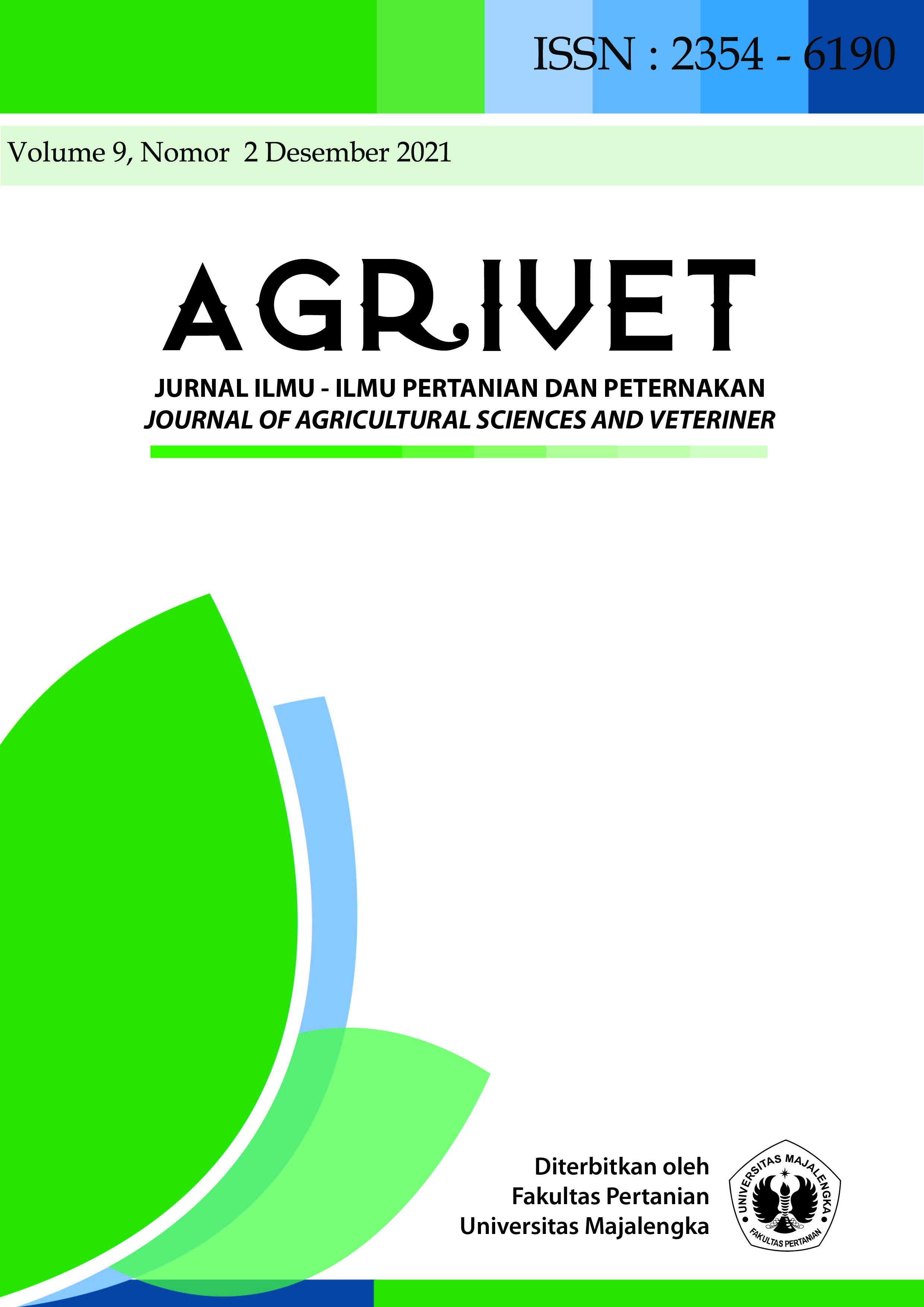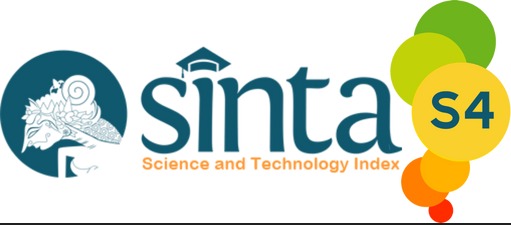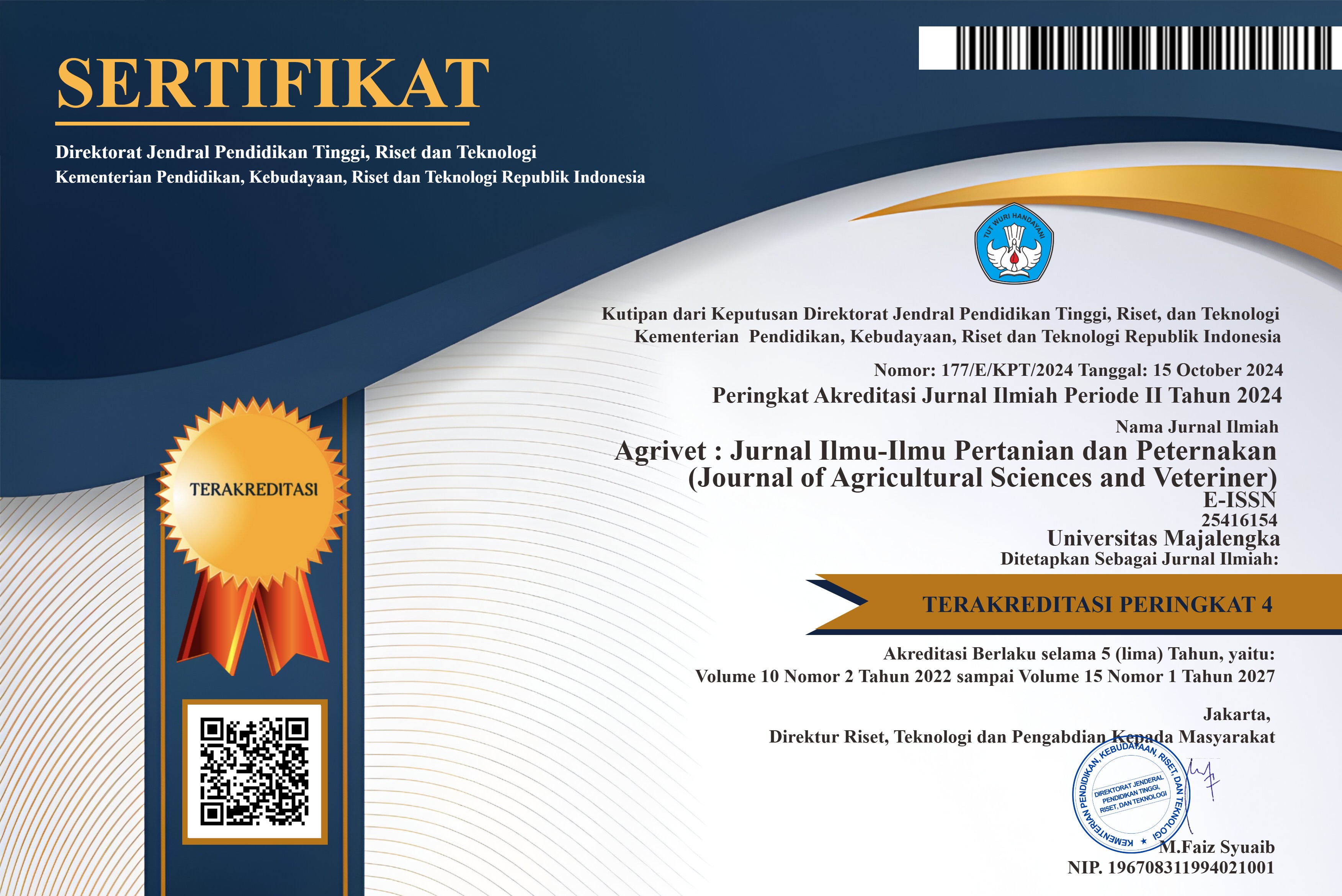PENGUJIAN BERBAGAI FORMULASI PUPUK TERHADAP PERTUMBUHAN DAN HASIL TANAMAN MELON (Cucumis melo L) PADA LAHAN KERING MASAM
DOI:
https://doi.org/10.31949/agrivet.v9i2.1702Abstract
Melon (Cucumis melo L.) contains various important vitamins and minerals, while melon consumption in Indonesia is still far below the standard. The increase in melon production every year has not met the needs of melons. Intensification of acid dry land is one of the efforts to increase melon production, because of the vast potential of the land, but it is necessary to improve the soil properties. The purpose of this study was to test the formulations on the growth and yield of melon plants on acid dry land. The study was conducted in a greenhouse using a non-factorial Randomized Block Design (RBD), with 8 treatments, namely: (A) without Lime + Phonska NPK Fertilizer (100%); (B) without Lime + Phonska NPK Fertilizer + Cow Manure (50%:100%); (C) without Lime + Phonska Npk Fertilizer + Petrobio Fertilizer (50%:100%); (D) without Lime + Phonska NPK Fertilizer + Cattle Fertilizer + Petrobio Fertilizer (50%:50%:50%); (E) with Lime + Phonska NPK Fertilizer (100%); (F) with Lime + Phonska Npk Fertilizer + Cow Manure (50%:100%); (G) with Lime + Phonska Npk Fertilizer + Petrobio Fertilizer (50%:100%); (H) with Lime + Phonska Npk Fertilizer + Cow Manure + Petrobio Fertilizer (50%:50%:50%) with 4 replications. Data analysis used Duncan's Multiple Range Test. The results showed that the fertilizer formulation with additional lime had a significant effect on fruit weight, fruit diameter, and fruit harvest age. Fertilization formulation without the need for high doses of organic fertilizer to achieve optimal yields.
Keywords:
Fertilizer formulation, liming, acid dry soilDownloads
References
Badan Pusat Statistik. 2020. Hortikultura Produksi Tanaman Buah Melon (Ton). Badan Pusat Statistik, Jakarta.
Irwan, A. W dan T. Nurmala. Pengaruh pupuk hayati dan pengapuran terhadap produktivitas kedelai di tanah Inceptisol Jatinangor. Jurnal Kultivasi, Vol. 17(2).
Ishak, M, A. Daryono, B, S. 2016. Kestabilan Karakter Fenotif Melon (Cucumis melo L. ‘Sun Lady’) Hasil Budidaya di Dusun Jamusan, Prambanan. D.I. Yogyakarta. Seminar Nasional Pendidikan Biologi Dan Saintek III. ISSN 2527 – 533X
Iswadi, 2020. Respon Tanaman Melon (Cucumis melo L) Terhadap Dosis Pupuk NPK Phonska Yang Berbeda. Fakultas Pertanian, Universitas Mataram.
Jenira, H, Sumarjan dan Armiani, S. 2016. Pengaruh kombinasi pupuk organik dan anorganik terhadap produksi kacang tanah (Arachis hypogea L.) varietas lokal bima dalam upaya pembuatan brosur bagi masyarakat. Jurnal Ilmiah Biologi Vol. 5(1) : 1-12
Kasno, A. 2019. Perbaikan Tanah untuk Meningkatkan Efektivitas dan Efisiensi Pemupukan Berimbang dan Produktivitas Lahan Kering Masam. Jurnal Sumberdaya Lahan Vol. 13 No. : 27-40
Kementerian Pertanian. 2018. Ekspor Buah Melon. Kementerian Pertanian Republik Indonesia. Jakarta.
Khumaero, W, W. et al. 2014. Evaluasi Karakteristik Hortikultura Empat Genotipe Melon (Cucumis melo L) Pusat Kajian Hortikultura Tropika IPB. Jurnal Hortikultura. Indonesia 5(1) : 56-63. April 2014.
Lestari, A. et al. 2018. Pengaruh Kombinasi Pupuk NPK dan Pengapuran pada Tanah Gambut Rawa Pening terhadap Pertumbuhan Tanaman Tomat (Lycopersicon esculentum Mill). Buletin Anatomi dan Fisiologi. Volume 3 Nomor 1. e-ISSN 2541-0083.
M. Maswar. 2018. Sistem Pengelolaan Lahan Kering Masam Untuk Mendukung Pengembangan Kawasan Pangan. Badan Penelitian Dan Pengembangan Pertanian Kementrian Pertanian. Bogor.
Mulyani, A. dan M. Sarwani. 2013. Karakteristikdan Potensial Lahan Sub Optimal untuk Pengembangan Pertanian di Indonesia. Jurnal sumberdaya Lahan Mo. 2 tahun 2013. Hal 47-56. Balai Besar Litbang Sumberdaya Lahan Pertanian, Bogor.
Newswire. 2018. Konsumsi Sayuran dan Buah Warga Indonesia di Bawah Standar. https://lifestyle.bisnis.com/read/20180423/106/787737/konsumsi-sayuran-dan-buah-warga-indonesia-standar-who. Diakses tanggal 16 mei 2021 jam 13.45.
Sevindrajuta. 2017. Respon Pertumbuhan dan Hasil Tanaman Melon (Cucumis melo L) Akibat Pemberian Tepung Cangkang Telur Dengan berbagai Jenis Pupuk Kandang. 2017. Jurnal Pertanian UMSB Vol.1 No.2 ISSN : 2527-3663
Simamora. H. K, N. Azizah dan T. Sumarni. 2019. Pengaruh Kombinasi Pupuk Vermikompos dan NPK pada Pertumbuhan dan Hasil Tanaman Tomat (Lycopersicum esculetum Mill) Varietas Servo. Jurnal Produksi Tanaman. 7(9). 1660 – 1668
Suryadi, M. (2018). Efektivitas Pupuk Petrobio Dan NPK Terhadap Pertumbuhan Dan Hasil Tanaman Kol Bunga (Brassica Oleracea Var. Botrytis L.). Mataram : Fakultas Pertanian Universitas Mataram.
Suryawaty, dan Wijaya R. 2012. Respon Pertumbuhan Dan Produksi Tanaman Melon (Cucumis Melo L.) Terhadap Kombinasi Biodegradable Super Absorbent Polymer Dengan Pupuk Majemuk Npk Di Tanah Miskin Hara. Program Studi Agroekoteknologi, Fakultas Pertanian UMSU Medan. Agrium, Volume 17 No 3.
Syahputra, D. Alibasyah, M. R. dan Arabia T. 2014. Pengaruh Kompos dan Dolomit Terhadap Beberapa Sifat Kimia Ultisol dan Hasil Kedelai (Glycine max L. Merril) Pada Lahan Berteras. Mahasiswa Pascasarjana Prodi Konservasi Sumberdaya Lahan Universitas Syiah Kuala, Banda Aceh.
Triharto, S. 2013. Survei dan Pemetaan Unsur Hara N, P, K, dan pH Tanah Pada Lahan Sawah Tadah Hujan di Desa Durian Kecamatan Pantai Labu. Skripsi. Fakultas Pertanian Universitas Sumatera Utara Medan.
Wahyuni, S, T. 2012. Pengaruh Pupuk Hayati Petrobio Dan N, P, K Pada Pertumbuhan Awal Tanaman Jarak Pagar (Jatropha Curcas L). Patj Pagar. Fakultas Pertanian UN IBRAW. Malang.
Yuningtias, A. P., Handajaningsih, M., dan Hasanuddin (2017) Respon pertumbuhan dan hasil tanaman melon (Cucumis melo L.) dengan pemberian dosis pupuk kandang kambing dan dolomit yang berbeda. Undergraduated thesis, Universitas Bengkulu.
Published
How to Cite
Issue
Section
License
An author who publishes in the Jurnal Agrivet agrees to the following terms:
- Author retains the copyright and grants the journal the right of first publication of the work simultaneously licensed under the Creative Commons Attribution-ShareAlike 4.0 License that allows others to share the work with an acknowledgment of the work's authorship and initial publication in this journal
- The author is able to enter into separate, additional contractual arrangements for the non-exclusive distribution of the journal's published version of the work (e.g., post it to an institutional repository or publish it in a book) with the acknowledgment of its initial publication in this journal.
- The author is permitted and encouraged to post his/her work online (e.g., in institutional repositories or on their website) prior to and during the submission process, as it can lead to productive exchanges, as well as earlier and greater citation of the published work









